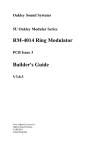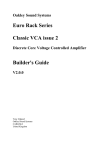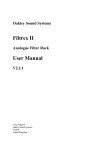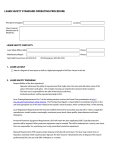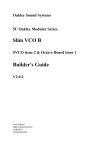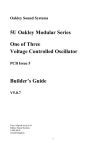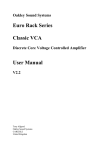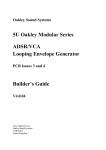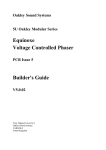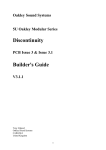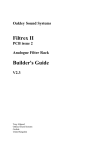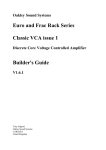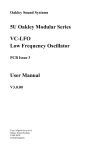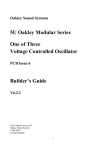Download Issue 3E Builder`s Guide
Transcript
Oakley Sound Systems Oakley Modular Eurorack Series RM-4014 Ring Modulator PCB Issue 3E Builder's Guide V3.1.0 Tony Allgood Oakley Sound Systems CARLISLE United Kingdom Introduction This is the Project Builder's Guide for the issue 3E RM-4014 Ring Modulator Euro module from Oakley Sound. This document contains a basic introduction to the board, a full parts list for the components needed to populate the board, a circuit description, and a list of the various interconnections. For the User Manual, which contains an overview of the operation of the unit and the calibration procedure, please visit the main project web page at: http://www.oakleysound.com/ringmod-e.htm For general information regarding where to get parts and suggested part numbers please see our useful Parts Guide at the project webpage or http://www.oakleysound.com/parts.pdf. For general information on how to build our modules, including circuit board population, mounting front panel components and making up board interconnects please see our generic Construction Guide at the project web page or http://www.oakleysound.com/construct.pdf. 2 The Issue 3E Ring Modulator PCB This is the issue 3E Euro sized Ring Modulator board fully populated and awaiting panel mounting and sockets wiring. This is one of our smaller format PCBs. The module is designed to fit into a Euro rack. The pots are Alpha/ALPS 16mm types with matching brackets. The module requires plus and minus 12V supplies. The power supply should be adequately regulated. The current consumption is about +/-38 mA. Power is routed onto the main PCB via the usual 2 x 5 way 0.1” (2.54mm) header for compatibility with Euro format modular systems. The top pins on the header are connected to the +12V supply. Reverse polarity protection diodes have been fitted although these should not be relied upon to protect your module for a long period of time. The PCB has four mounting holes for M3 bolts, one near each corner. These are not required if you are using our specially made pot brackets. The size of the board is 96.5mm high by 86.4mm deep. The input and output sockets are wired to the board via an eight way 0.1” Molex or MTA interconnect. 3 Ring Modulator issue 3E Parts List For general information regarding where to get parts and suggested part numbers please see our useful Parts Guide at the project web page or http://www.oakleysound.com/parts.pdf. The components are grouped into values, the order of the component names is of no particular consequence. A quick note on European part descriptions. R is shorthand for ohm. K is shorthand for kiloohm. R is shorthand for ohm. So 22R is 22 ohm, 1K5 is 1,500 ohms or 1.5 kilohms. For capacitors: 1uF = one microfarad = 1000nF = one thousand nanofarad. To prevent loss of the small ‘.’ as the decimal point, a convention of inserting the unit in its place is used. eg. 4R7 is a 4.7 ohm, 4K7 is a 4700 ohm resistor, 6n8 is a 6.8 nF capacitor. Resistors All 5% carbon 1/4W or better, except where stated. 220R 470R 680R 1K 4K7 10K 12K 15K 18K 39K 56K 1M 2M2 R20 R19 R6, R16 R10 R22, R4 R9, R1, R2, R8 R14 R11 R7, R15, R18 R3, R21 R13 R12 R5, R17 Capacitors 15pF 2.5mm C0G ceramic 47pF 2.5mm C0G ceramic 100nF axial multilayer ceramic 1.5uF or 2u2, 63V or 50V polyester 2.2uF, 25V electrolytic C11 C3 C7, C8, C9, C10, C15, C16 C1, C6 C4, C17, C13, C14 4 Discrete Semiconductors 1N4004 rectifier diode 1N4148 signal diode BC550 NPN transistor BC560 PNP transistor D7, D8 D1, D2, D3, D4, D5, D6 Q2, Q4 Q1, Q3 Integrated Circuits TL072 dual op-amp THAT320P PNP array THAT300P NPN array U2, U3 U1 U4 Variable Resistors 50K or 100K multiturn trimmer BAL1, BAL2, GAIN 100K linear Alpha 16mm pot 50K linear Alpha 16mm pot X-LEVEL, Y-LEVEL Y-OFFSET Pot brackets Three off Miscellaneous Leaded ferrite beads L1, L2 2 x 5 (10-way) 0.1” box header PSU 0.1” 8-way Molex or MTA header SOCKETS 0.1” 8-way Molex or MTA housing SOCKETS DIL14 pin IC sockets DIL 8 pin IC sockets – board mounted – wire harness Two off Two off Other Parts Required 3.5mm sockets Five off mounted on panel Three 20mm knobs. Around 2m of insulated multistrand hook up wire for the socket connections. 5 Circuit description A ring modulator is sometimes described as a four quadrant multiplier, and while this certainly sounds more grand, it also explains the action of the device in more detail. The four quadrants refer to the four quarters of a standard XY graph with the origin in the middle. The idea being that this device allows two inputs, we will call them X and Y, of either positive or negative voltage, to be multiplied together. The output is therefore either positive when both X and Y are the same polarity, or negative when they are different. A standard voltage controlled amplifier (VCA) can be considered as two quadrant multiplier since one of its inputs can only be of a positive value. The two quadrants where Y is negative are not computed, and the output normally remains at zero when Y is not positive. In audio when an input signal is processed so that it changes from a positive value to a negative one we say it has been inverted, or that it is 180 degrees out of phase with the original. In this way, a ring modulator may be considered to change the phase of one of its inputs depending on the polarity of the other. In a perfect ring modulator the inputs X and Y can be considered as having the same functions as each other. ie. X x Y = output = Y x X In our real life ring modulator this is not true. Imperfections in the circuit topology means that the output will sound different, or behave differently, depending on which signal you insert into X and which into Y. Generally, we will use X as our input signal (sometimes called the carrier), and Y as our modulator. That is, Y will shape X. In many applications it doesn't make too much difference which is which, so experimentation is the key here. The Oakley Ring modulator is based around the old ARP module 4014. This was built on an incredibly tightly cramped circuit board which was then securely potted, with a very hard epoxy compound, into a small plastic box. The various interconnections were made to some thin gold plated legs that stuck out from the hard epoxy on the underside. It is almost impossible to remove the circuitry from its hard plastic shell and all encompassing resin. I suppose this was mostly down to Alan Pearlman's previous history in making op-amps for the aerospace industry – enclosing circuits like this would make them less likely to drift with temperature and be affected by surrounding humidity. However, one might also think that they did it to keep out the prying eyes of their competitors. Later versions of the 4014 used soft and rubbery silicone to pot the circuitry into its shell with only a thin layer of epoxy on the underside to seal it all in. These are easier to repair since it is now possible, with great care, to remove the delicate circuitry from its shell and potting compound. Various folk have since reverse engineered this circuit and it can be found in various places on the internet. The basic function of the 4014 is of two complementary VCA circuits, both controlled by a single driver, and each feeding a common current to voltage output stage. The driver features 6 a non linear gain that acts as a pre-distortion device which compensates for some of the non linearities in the VCA sections. The very first Oakley ring modulator module built to replace a dead ARP-4014 module in an ARP2600 synthesiser. The Oakley RM-4014 module borrows heavily from the design shown here. U3, a dual op-amp, is configured as two voltage followers, one for each input. The signal level to each one is controlled via its own level pot. The source of the signal can come from either a direct coupled input via a single resistor, or AC coupled via a capacitor. The capacitor in conjunction with the resistor following it and the pot itself will act as a high pass filter. This will attenuate very low frequency signals with a -3dB point of around 1Hz. It is possible to use both the AC and DC inputs simultaneously thus creating a crude two channel mixer. However, although no harm to the unit will come about, it does cut down the overall signal level presented to the input level pot. Both U3 halves act as protective buffers for the relatively high output impedance of the level pots. The lowish input resistances of the ring modulator input stages would otherwise detrimentally affect the pots' apparent taper, the cut-off frequency of the AC coupled input, and perhaps also the output stage of the connected modules. The ring modulator core is built from two transconductance amplifiers that are complementary to one another. A transconductance amplifier is basically a 'voltage in, current out' device whose gain, in this case, is controlled by another modulating current. And complementary in this definition means identically opposite, mirrored if you like. In other words they behave 7 mostly the same but one is modulated by positive currents from the driver, the other negative currents. Since the driver is common to both of them and its own output is either positive or negative, only one of the transconductance stages is active at any one time. I have tried to draw the schematic so you can see the two complementary halves of the core easily. Each one appears identical but for the type of transistors used. Where one uses a NPN, the other will use a PNP, and vice versa. Note too, that the X input is applied to different sides of the transconductance stages resulting in one of them being of opposite phase to the other. The left hand side deals with Y modulation signals that are positive in value. The right hand side deals with Y modulations that are negative in value. Each transconductance amplifier is made from five transistors. Four are two sets of matched pairs. A matched pair is exactly that; two devices that share with almost identical characteristics. This cannot usually be obtained from simply buying two transistors of the same type, since in manufacturing there are small discrepancies that make every device slightly unique. In the original 4014 module, ARP would have hand selected their transistors by trying hundreds out and grouping them together into large bins with contained those devices with similar characteristics. Each pair would then be made by selecting two devices from the same bin. This would take too much time when you only want to build one or two Oakley Ring Modulators, so I have used pre-matched quad transistor arrays. The THAT300 is four matched NPN transistors, and the THAT320 is four matched PNP transistors. The electronic matching is near perfect and they are also made onto the same silicon die and in the same housing thus ensuring a good thermal matching too. The voltage at the top of each transconductance stage is fixed by diodes to be 1.2V for the left hand side one and -1.2V for the right hand side. C4 and C17 provide some additional decoupling to reduce any noise or audio signal bleedthrough at these points. C4 and C17 were not in the original design, but I have added them here to reduce any chance of extraneous noise pick up. The output of both transconductance stages go to the inverting input of the output op-amp, U2, pins 1, 2 and 3. This is wired as an inverting transimpedance amplifier, which is a 'current in, voltage out' device and essentially the opposite of a transconductance amplifier. A transconductance amplifier followed by a transimpedance amplifier make an amplifier, ie. 'voltage in, voltage out'. To make sure the overall gain of the ring modulator is positive for Y being positive, we use the inverting outputs from each transconductance amplifier. These are found on the collector of the left hand transistor of the input pair, ie. U14, pin 14 and U1, pin 7. The gain of the transconductance amplifiers is controlled by the driver circuit. The output of the driver circuit is converted to a current by R18 which in turn affects the current through the input pairs and hence the amplitude of the current output. However, the response of gain versus input current is not linear when the output of U2 is less than 0.6V for the left hand amplifier and above 0.6V for the right hand one. This is because to control the gain of the transconductance amplifiers the voltage at the bottom of R18 must be enough to overcome the inherent base-emitter voltage and turn on either of the input transistor pairs. This would give rise to a dead zone of operation if it were not for the deliberate non linearity introduced in the driver circuit. 8 Q3 and Q4 are wired as diodes in the feedback of the driver op-amp. This means for output voltages between -0.6V and +0.6V the gain of the op-amp is very high indeed as it is pretty much set solely by the ratio of R12 and R11. Thus even a small voltage on the Y input will lead to either +0.6V or -0.6V depending on the polarity of the input. Once this voltage has been achieved any increase in input voltage will decrease the gain as either Q3 or Q4 turns increasingly on. Eventually, the gain tends to the ratio of R15 and R11, a much smaller figure. Unlike the original circuit application, the Oakley Ring Modulator allows you to add a positive offset voltage to the Y input voltage. Thus effectively increases the gain of the left hand transconductance amplifier thus allowing the non inverted X signal to pass through to the output even when no positive Y input is present. Power is supplied via the usual 10-way 0.1” header. As is the custom for Oakley modules, I have used ferrite beads to act as high frequency filters on the power lines. Decoupling at the point of entry is provided by C13 and C15 for the positive rail, and C14 and C16 for the negative rail. Additional decoupling is also provided elsewhere on the board by the other capacitors shown at the bottom of the schematic. All these capacitors keep the power supply clean of noise, and provide a reservoir for the little bursts of current that the circuit takes in normal operation. D7 and D8 provide some protection against the power lead being connected in reverse. 9 Connections Power is admitted to the module via a boxed 10-way IDC header. The sockets are connected via an optional 8-way Molex 'strip and crimp' style 0.1” header and housing. Power connections Power is provided via the standard Doepfer power header system. This is a 10 way header based on a 2 x 5 0.1” grid. It is not typical to use a boxed keyed header as Doepfer uses an unenclosed set of pins. However, I, and others, prefer these shrouded headers as it lessens the chance of reversing the power lead and frying the electronics of the module. The issue 3E Ring Modulator PCB does have reverse protection diodes. In the event of power reversal these will conduct and draw a large amount of current. This should cause the power supply to go into current limit. However, this current may be large enough to eventually burn out the diodes and damage them. The protection diodes are therefore only suitable for protection for a short period of time. It is possible to replace L1 and L2 with quick acting semi-conductor fuses. I am not experienced in using these devices but other designers have used them with success. When activated they will effectively reduce the current taken by the diodes and protect all the components on the module for a great deal longer than the diodes would on their own. I'll be glad to hear of people's experiences with these devices if you do choose to use them. Bear in mind though that when the fuses are not tripped they do still have some resistance. This small resistance will reduce the voltage to the module a bit and this may have some audible affect. 10 The pin out for the connector is shown below. Note that the pin numbering of the header are different to that of an integrated circuit. Here they go from left to right and then move down the connector, rather than count down and then up as you would an IC. Pin Number Connection 1 2 3 4 5 6 7 8 9 10 +12V +12V Module Ground Module Ground Module Ground Module Ground Module Ground Panel Ground -12V -12V Panel and Module Ground The module ground and panel ground are both connected to 0V at the power supply or power distribution board. The module ground is the 0V supply to the module electronics. The panel ground, while it is still at the same potential, connects to the input and output sockets' screen connection. If you are using metal sockets this will ensure that the module panel is then directly connected to the power supply's ground and not via the module's more sensitive 0V line. Using plastic sockets will simply float the panel with respect to the module but the panel will then be grounded via the modular's casing or mounting rails. Both of these ways seem preferable to connecting the module's sockets and panel to the local 0V where ground currents could travel down any patch cable's screen connection. But in either case any Oakley module wired in such way will still be compatible with any other Euro module. The current version of the Krisp1 Oakley Ring Mod. Older versions have only two input sockets and two switches. 11 Wiring the sockets How you wire your input and output sockets up will very much depend on your panel design and choice of sockets. I will only go into the details of wiring up a panel with the five 3.5mm sockets. One variant of the Krisp1 built RM-4014 uses only three sockets, one output and two inputs, but has also two switches to select between AC and DC inputs. This replicates the circuit of the original 2600. However, by using four input sockets you can use the module as a crude mixer. Both the AC and DC inputs are active at the same time and can be used to process two signals at once. The standard 3.5mm chassis mount socket. The metal bush means that the panel will be electrically connected to the socket's ground lug. The ground lug is the one that sticks out from the side of the socket. If you have used ordinary 3.5mm sockets with a metal bush (see picture above) you will see that they have three connections. One is the earth lug or ground tag, which connects the metal mounting bush. The second is the signal tag which will be connected to the tip of the jack plug when it is inserted. The third tag is the normalised tag, or NC (normally closed) lug. The NC lug is internally connected to the signal tag when a jack plug is not inserted. This connection is automatically broken when you insert a jack. We shall not be using the NC lugs at all on this module. Firstly, we are going to ‘common’ the sockets’ ground lugs. This means that the sockets’ ground lugs are going to be joined together. I normally do this part of the wiring without the PCB or pots in place on the panel. Fit the five input signal sockets onto the panel so that the ground tag sticks down towards where the PCB will be. Solder a length of thin solid core wire right across all the earth tags. Trim off any excess that sticks out on either end. This wire will be eventually connected to either panel ground pin on the SOCKETS header – pin 6 or 8. Fit the Ring-modulator PCB against the front panel if you haven't done so already. I used Molex KK headers and housings to connect my ring modulator together. This way I don't have to solder my wiring to the PCB. However, you can solder directly onto the board if you wish. The 0.1” solder pads are substantial enough to be able to solder the usual hook up wire to. 12 Use multistrand hook up wire to connect each socket lug to the relevant pin on the header. Keep your wires short but not too short and you can use as many different colour wires as you can – although I tend to use one colour because I'm a minimalist. There is absolutely no need to use screened cable for such short runs. The connections of the lugs of the CV and audio output sockets that go directly to the PCB are summarised in the table below. They are given in the order in which I would recommend that they be soldered. Socket Name Lug type Header Pin number All sockets IN X (DC) IN X (AC) IN Y (DC) IN Y (AC) XxY Earth Signal Signal Signal Signal Signal 6 or 8 1 2 4 5 7 Note: Pin 1 is the square solder pad on the PCB. All the other solder pads on the header are round. Pin 3 is not used. Once the wiring is done your module is ready for testing and calibration. 13 Testing, testing, 1, 2, 3... Apply power to the unit making sure you are applying the power correctly. Check that no device is running hot. Any sign of smoke or strange smells turn off the power immediately and recheck the polarity of the power supply, and the direction of the ICs in their sockets. Assuming everything is OK so far, it is time to apply an audio input. Use a signal like a triangle output from a VCO. Middle A, 440Hz is a good note to use. Turn down all the pots to their minimum setting and insert your triangle wave signal into IN X (AC). Listen to the output signal from the ring modulator module. For the moment you should hear nothing. Turn up the X LEVEL pot to full. Again, you shouldn't hear anything, but maybe you will hear a little triangle wave bleedthrough. Now slowly turn up the Y OFFSET pot. If all is well this should behave like a volume control, increasing the level of the triangle wave as it is turned up. Ensure that altering Y LEVEL should have no effect on the sound, but that X LEVEL behaves also like a volume control. It should seem that both X LEVEL and Y OFFSET do the same thing. They do not of course, since X LEVEL is altering the signal level going into the ring modulator circuit, and Y OFFSET is adjusting the gain of the amplification within the ring modulator. Swap the input signal over to the IN X (DC) input. This should have no apparent effect on the sound. There is a very good chance your circuit is working correctly if you have got this far with no problems. However, we still need to check a few other things and you'll need another signal source to do this. Connect a LFO or VC-LFO to the IN Y (DC) input. Use a sine or triangle wave signal at a lowish frequency, say 1Hz or so. Turn the Y OFFSET down and the X LEVEL up. Now slowly turn the Y LEVEL up and listen to the resultant sound. It should be the triangle wave you can hear again, but it will pulse up and down with LFO signal. You should hear it go up and down in volume twice for every cycle of the LFO, ie. at 2Hz if you have set your LFO to 1Hz. This is because, unlike an ordinary VCA, the triangle wave is being multiplied by both the positive and negative parts of the LFO's waveform. Thus you get a rise in volume with increasing positive voltages and a rise volume with increasing negative ones. If you increase the Y OFFSET pot to its maximum value, you should find that you now have only one cycle of volume change per LFO cycle. The offset pot has added a positive voltage to the Y input thus making it solely positive in value. If all is well, then you have a working ring modulator module. 14 Final Comments If you have any problems with the module, an excellent source of support is the Oakley Sound Forum at Muffwiggler.com. Paul Darlow and I are on this group, as well as many other users and builders of Oakley modules. If you can't get your project to work, then Oakley Sound Systems are able to offer a 'get you working' service. If you wish to take up this service please e-mail me, Tony Allgood, at my contact e-mail address found on the website. I can service either fully populated PCBs or whole modules. You will be charged for all postage costs, any parts used and my time at 25GBP per hour. Most faults can be found and fixed within one hour, and I normally return modules within a week. The minimum charge is 25GBP plus return postage costs. If you have a comment about this builder's guide, or have a found a mistake in it, then please do let me know. But please do not contact me or Paul Darlow directly with questions about sourcing components or general fault finding. Honestly, we would love to help but we do not have the time to help everyone individually by e-mail. Last but not least, can I say a big thank you to all of you who helped and inspired me. Thanks especially to all the nice people on the SynthDIY and Analogue Heaven mailing lists and at Muffwiggler.com. Tony Allgood at Oakley Sound Cumbria, UK © May 2012 – updated September 2014 No part of this document may be copied by whatever means without my permission. 15















